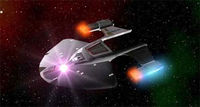USS Aegis Specifications
| USS Aegis | ||
|---|---|---|
 INACTIVE STATUS | ||
| ||
General
- Commanding Officer: Captain Sal Taybrim - Ship Chief Stewart
- Category: Medium Cruiser
- Primary Designation: Diplomacy
- Expected Duration: Minor : 1 year Major : 20 years
- The Aegis Motto: "Ut incepit fidelis sic permanet" aka. "Loyal she began, loyal she remains"
Personnel
- Officers: 45
- Enlisted Crew: 90
- Marines: 45
- Passengers: 10
- Evacuation Limit: 500
Speed
- Cruising Velocity: Warp 6
- Maximum Velocity: Warp 8.4
- Emergency Velocity: Warp 9.7 (for 12 hours)
Dimensions
- Length: 445.02 meters
- Width: 275.24 meters
- Height: 64.00 meters
- Weight: 758,840 Metric Tonnes
- Cargo Capacity: 32,200 Metric Tonnes
- Hull: Duranium-Tritanium composite
- Number of Decks: 17 Total, 16 Habitable.
Auxiliary Craft
- Type-8 Medium Short-Range Shuttlecraft: 2
- Type-9 Medium Long-Range Shuttlecraft: 2
- Type-11 Heavy Long-Range Shuttlecraft: 2
- Work Bee-Type Maintenance Pods: 3
Armament
- Phasers: 6 x Type IX phaser bank, total output 9,000 TeraWatts
- Photon Torpedoes: 2 x Standard photon torpedo tube with 50 rounds
- Quantum Torpedoes: 0
Shielding Systems
- Standard shield system, total capacity 945,000 TeraJoules
- Standard Duranium/Tritanium Single hull.
- Standard level Structural Integrity Field
Alerts
- Cruise Mode - The normal operating condition of the ship.
- Yellow Alert - Designates a ship wide state of increased preparedness for possible crisis situations.
- Red Alert - Designates an actual state of emergency in which the ship or crew is endangered, immediately impending emergencies, or combat situations.
- Blue Alert – Mode used aboard ships with planetfall capability when landing mode is initialized.
- External Support Mode - State of reduced activity that exists when a ship is docked at a starbase or other support facility.
- Reduced Power Mode - This protocol is invoked in case of a major failure in spacecraft power generation, in case of critical fuel shortage, or in the event that a tactical situation requires severe curtailment of onboard power generation.
Atmospheric Entry
The USS Aegis is capable of atmospheric entry and egress with equipment worked into the physical design of the starship. Each Norway Class vessel is equipped with anti-gravity generators as well as impulse and RCS lifters strategically placed at the mass and stress points on the bottom portion of the main saucer section as well as balancing thrusters on the aft-bottom of the catamarans.
It is standard procedure to lower the landing gear at approximately 2500m above the Landing Zone surface, regardless of Landing Zone altitude. This minimizes the drag on the vessel. Once prepared for landing, Aft impulse engines are shut down and four vents on the ventral hull are opened.
These vents cover the ventral impulse thrust plates. Impulse engines in miniature, the thrust plates serve only to provide lift to the vessel as the anti-gravity generators effectively reduce its weight. The RCS thrusters provide final maneuvering power.
Once on the ground, crew or equipment can be transported to the surface from the vessel, there are a few ways to exit the ship. One is a a large cargo hanger with a drop ramp decking inside that extends the the ground. Another is a Hold that houses a few ground vehicles like that of the Argo, this hold lowers out of deck 16 like a cube to the ground, the roll up bay doors then can open like that of a garage. Inside there are telescoping ladders that lower with the hold. The last way is a extending turbo lift that is in all three landing struts, that opens to a small tactical and equipment locker in the the feet of the struts and then out on the ground from a hatchway.
This feature makes the Norway class a great options as a temporary planetary lab. Or hospital in a break out.
Take-off is done in reverse.
